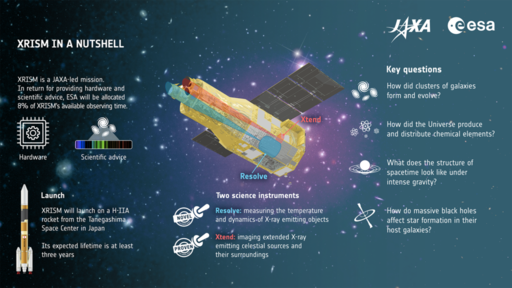On August 26, the Japan Aerospace Exploration Agency (JAXA) plans to launch a new X-ray telescope XRISM. It will study the Universe, its large-scale structure, and also try to identify traces of mysterious dark matter.
Heir of the lost observatory
The history of XRISM goes back to 2016, when JAXA launched a new X-ray telescope Hitomi. At that time, it was the largest and most complex scientific instrument in the history of the land of the Rising Sun. Very high expectations were placed on it: it was believed that Hitomi would launch a new era of X-ray astronomy.
Unfortunately, this never happened. Just 37 days after the launch, Hitomi was lost in a very disappointing accident. Its cause was a failure in the stabilization system of the spacecraft. The on-board computer mistakenly decided that the Hitomi began to rotate around its axis and decided to “correct” the situation with the help of the main engines. This led to the fact that the telescope spun, and the centrifugal force simply tore off all the fragile and protruding elements, including solar panels. After that, the 285-millionth spacecraft could no longer be saved.

The death of the telescope was a heavy blow both for JAXA and for the world scientific community, because it entailed the threat of a long “break” in X-ray observations of the sky. The fact is that other operating space X-ray observatories (Chandra, XMM-Newton and NuSTAR) were launched quite a long time ago, and they have already gone far beyond their nominal service lives. In turn, the flagship mission of the next generation Athena, which is being prepared by ESA, will go into space no earlier than the mid-2030s.
Therefore, JAXA started creating a replacement for Hitomi. The new telescope was designated XRISM (X-Ray Imaging and Spectroscopy Mission).
Technical design and launch date of XRISM
The mass of XRISM is 2.3 tons. Although the spacecraft is created as a replacement for Hitomi, its scientific load is not identical to the deceased predecessor. Hitomi was equipped with four instruments, thanks to which it could conduct observations in both the soft and hard X-ray range.

As for XRISM, its designers decided to limit themselves only to the soft X-ray range. The scientific filling of XRISM is represented by two scientific instruments. One of them was made by Japanese specialists, the second was provided by NASA.
ESA also contributed to the project. The organization provided an optical telescope necessary for targeting XRISM, as well as devices that would measure the Earth’s magnetic field and ensure the correct orientation of the spacecraft.
The launch of the new Japanese telescope is scheduled for August 26. The H-IIA rocket will be used for the mission. It will take the spacecraft into a 550-kilometer near-Earth orbit. The Hubble telescope operates at about the same height.
Main scientific tasks of XRISM
One of the main tasks of XRISM will be the study of hot gas flooding galactic clusters. This will allow scientists to determine their mass, which in turn will reveal how the formation and evolution of the Universe take place.

XRISM observations give an insight into how the formation and distribution of chemical elements take place in the Universe. The hot gas inside the clusters remained after the birth and death of numerous generations of stars. By studying the X-ray radiation it emits, XRISM will be able to find out which elements heavier than hydrogen and helium it contains and then make a map of their enrichment in the Universe.
Another task of the mission will be to study individual sources of X-ray radiation. These include supernovae, pulsars and supermassive black holes located in the cores of active galaxies. The latter category is of particular interest. Scientists would like to know how supermassive black holes bend the surrounding space and to what extent the jets produced by them affect the parent galaxies.
And finally, XRISM also maps the large-scale structure of the Universe. This will help astronomers estimate the distribution of dark matter in it.
The nominal service life of the XRISM should be three years. But JAXA hopes that, in reality, the spacecraft will work much longer. In this case, it will be able to become a link between the previous generation of X-ray observatories and the new telescopes that will be launched in the next decade.
Follow us on Twitter to get the most interesting space news in time
https://twitter.com/ust_magazine
